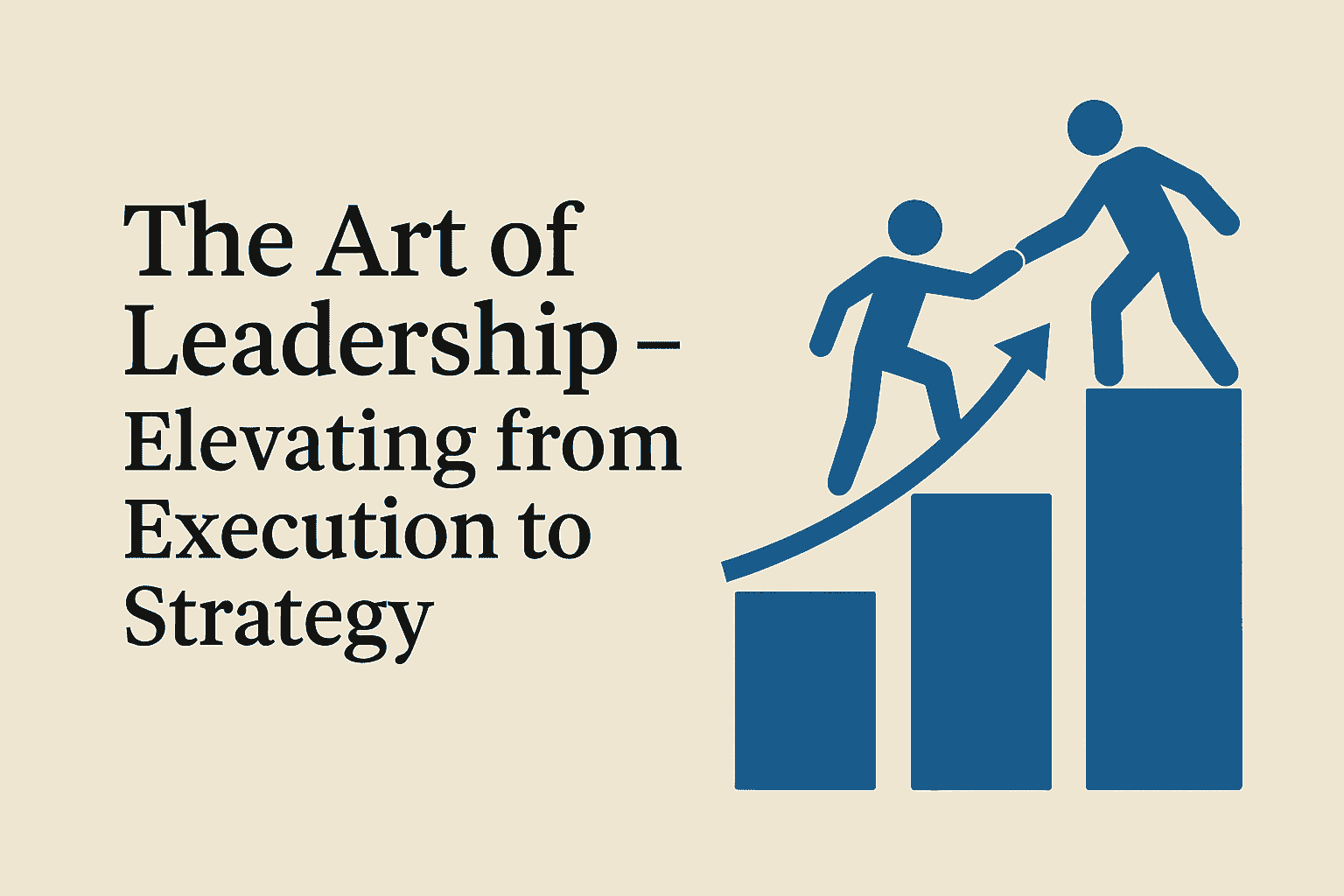The Art of Leadership – Elevating from Execution to Strategy
The leap from execution to a strategic leadership role isn’t just a promotion—it’s a fundamental shift in mindset, skillset, and approach. You are no longer executing plans but shaping the future of the company.
Product strategy serves as the bridge between a company’s vision and execution. While the role of a Product Strategy team may vary across organizations, its core function remains the same—defining high-level objectives spanning multiple years while continuously refining them to adapt to market shifts.
“A good strategy is not a collection of goals, nor is it a vague hope or wish list. It is about focusing on a few critical objectives and actions that can make a significant difference.”
— Richard P. Rumelt, Good Strategy/Bad Strategy
When I joined the Product Strategy team, I was immersed in this strategic shift firsthand. Unlike traditional product management, where success is measured by individual product impact, this team focuses on shaping the strategy of the entire product organization. This journey has been about leading digital transformation—redefining how products, processes, and teams work together for long-term success.
From Execution to Vision – Shifting the Mindset
Stepping into a product strategy role felt like entering a new dimension. Instead of detailed feature discussions and sprint planning, I was studying multi-year business strategies across markets. The contrast was profound—I went from launching great products to understanding how technology drives business growth at scale.

Building a product just for the sake of it isn’t a strategy, it’s busywork. Strategic leadership requires stepping back and asking critical questions –
• How does this initiative propel the business forward?
• Does it align with the company’s long-term goals?
• What impact does it have beyond immediate execution?
As teams scale, friction increases. Alignment between teams, decision-making processes, and execution become more complex. As a product strategy leader, my focus shifted to orchestrating processes, key metrics, business case development, and data-driven decision-making to ensure alignment.
At first, it was tough to resist diving into tactical product details. But managing initiatives across six markets and hundreds of tech initiatives required me to zoom out and adopt a broader business lens. This shift wasn’t just about frameworks—it was about evolving as a thought leader. Digital transformation isn’t a sprint but a marathon that demands patience, influence, and perseverance.
“Product culture is crucial for building an effective product management organization because it drives teams to focus on outcomes, not just outputs.”
— Melissa Perri, Product Thinking Podcast
A strong product strategy team doesn’t push out features—it ensures every decision contributes meaningfully to business success.
Connecting Initiatives to Business Outcomes
Success in product strategy is measured differently. As a product manager, my metrics were adoption rates, NPS scores, and cost savings. In strategy, however, impact unfolds over a longer horizon, measured by revenue growth, market share, and profitability.
For strategy leaders, measuring impact isn’t straightforward. Unlike product managers, who directly influence product success, strategic leaders shape company direction. Their initiatives drive revenue, efficiency, or customer satisfaction—but results take time to materialize. This makes it critical to apply product thinking at a strategic level.
Balancing customer needs with business objectives became the core of my decision-making process. It was no longer about optimizing a single product’s success but ensuring a portfolio of initiatives worked cohesively to drive the company forward. Strategic leaders must think beyond features and roadmaps, asking:
• Will this investment move the bottom line?
• Will this initiative create sustainable growth?
Though strategy leaders may not be in the trenches of execution, their role is pivotal in shaping long-term success.
Bridging the Gap – Developing Business Acumen
At this point, I had embraced the big-picture thinking, but there was one challenge I couldn’t avoid—finance. I never liked Excel. I was good at math, but finance always felt intimidating. As an engineer turned product manager, I was comfortable with technology but never keen on business finance. Even in business school, my finance class was the one I dreaded the most.
However, in a strategic role, you can’t run from finance.
I remember my manager telling me, “You don’t need to be a pro like the CFO, but you do need to understand the basics and communicate effectively with leadership.” He was right. Investment allocation, benefit estimations, and financial trade-offs became part of my daily work. These conversations weren’t just about numbers; they were about shaping billion-dollar strategies.
At first, I felt out of my depth. Apart from crying over not paying much attention in Finance class in grad school, I went back to revisit common finance terms and concepts—thankfully, the internet has an abundance of free resources tailored for product managers. You just need time and motivation—or sheer desperation before an important meeting—to go through it.
Second, I started asking dumb questions in conversations with financial partners to understand the terminologies and logic better. At first, I worried they’d think I was clueless, but I realized that even seasoned leaders ask fundamental questions to get clarity. Turns out, finance folks appreciate product managers who want to understand their world! That said, depending on your company’s policies and your specific function, direct access to finance managers and their support might be limited. But that shouldn’t stop you—basic finance knowledge is free and abundant, and even a foundational understanding can go a long way in strategic decision-making.
Communicating with Precision – The Power of Clarity
If there’s one indispensable skill in a strategy role, it’s communication.

Crafting presentations, writing whitepapers, and simplifying complex ideas are daily tasks. Senior executives don’t have time for excessive details—they need sharp, actionable insights. Just one or two slides must capture attention and drive decisions. Every word, data point, and visual matters.
Beyond long-term vision, the strategy team also refines frameworks to improve product management across the organization—creating playbooks and best practices that help product teams operate effectively.
Balancing Quick Wins and Long-Term Success
Strategy isn’t just about playing the long game—it’s about knowing which games are worth playing.
In product management, sprint cycles drive quick wins. In strategy, the pace is slower, but the stakes are higher. It’s about ensuring today’s initiatives also set the company up for future success.
Take GenAI, for example. Every company wants in, but not every initiative is a slam dunk. Some implementations deliver fast results while others take months or years to prove value. Strategic leaders must evaluate opportunities through desirability, feasibility, and viability to ensure they truly move the business forward.
Leading Cross-Functionally – Building Influence and Alignment
In a strategic leadership role, decision-making impacts the entire organization. Every function—Engineering, Finance, Marketing, Sales, Operations—has a stake in the game, and they all speak their own language.
To drive alignment, strategic leaders must do more than set a vision. They have to sell it. This means simplifying complex ideas, tailoring communication for different audiences, and building trust. A well-crafted strategy is useless if no one buys in.
Product leaders must cultivate executive presence, distill complex ideas into simple concepts, and earn trust across teams. Storytelling is one of the most powerful tools—facts and figures matter, but people connect with narratives. The goal isn’t just getting everyone on board—it’s making sure they’re rowing in the right direction.
Thinking Strategically – Developing the Right Mindset
An important realization– Strategy isn’t about grand boardroom decisions. It’s about pattern recognition—spotting opportunities, connecting dots, and asking the right questions before anyone else does. The best strategists don’t wait for the “big picture” to be handed to them—they build it piece by piece, long before they have an official strategy title.
A strong product strategy requires tough trade-offs and prioritization. It’s not a title—it’s a mindset. It’s about zooming out from tactical execution to think bigger, bolder, and longer-term.
This transition isn’t always comfortable. It means stepping away from the familiar rhythm of roadmaps and release cycles, embracing ambiguity, and thinking in years—not just quarters. You start connecting product decisions to business outcomes, weighing trade-offs that don’t always have clear answers.
But here’s the real payoff—you’re no longer just shipping products. You’re shaping the company’s future, making bets that define markets, shift customer expectations, and create lasting impact.
Cultivating Strategic Thinking: Try These Exercises
• Reverse-engineer strategic decisions – Analyze major company moves (acquisitions, product launches) and break down their rationale.
• Connect cross-functional insights – Engage with teams outside of product (finance, sales, operations) to understand how different functions contribute to business success.
• Analyze the competitive landscape – Pick a market or product category, research key players, and identify gaps or opportunities.
• Scenario planning – Take a current product challenge and map multiple future scenarios based on market shifts and customer behavior.
• Expand your strategy toolkit – Read articles, listen to podcasts, and explore books on product strategy to stay ahead of trends.
So, whether you’re a product manager, engineer, or marketer, start flexing those strategic muscles now. Pay attention to how different functions connect, dig into business drivers, and think beyond immediate execution.
The best time to start is now. No title required.
About Author:
Parul Jain is a seasoned product leader with 10+ years of experience driving AI-powered innovation across telecom, mobility, fintech, retail, and e-commerce. She currently leads Product Strategy at Walmart International, driving scalable product innovation and aligning business objectives across global markets. Passionate about enhancing customer experiences and operational efficiency, she thrives at the intersection of business and technology.
.gif)




.avif)
.avif)

.avif)
.avif)
.avif)

